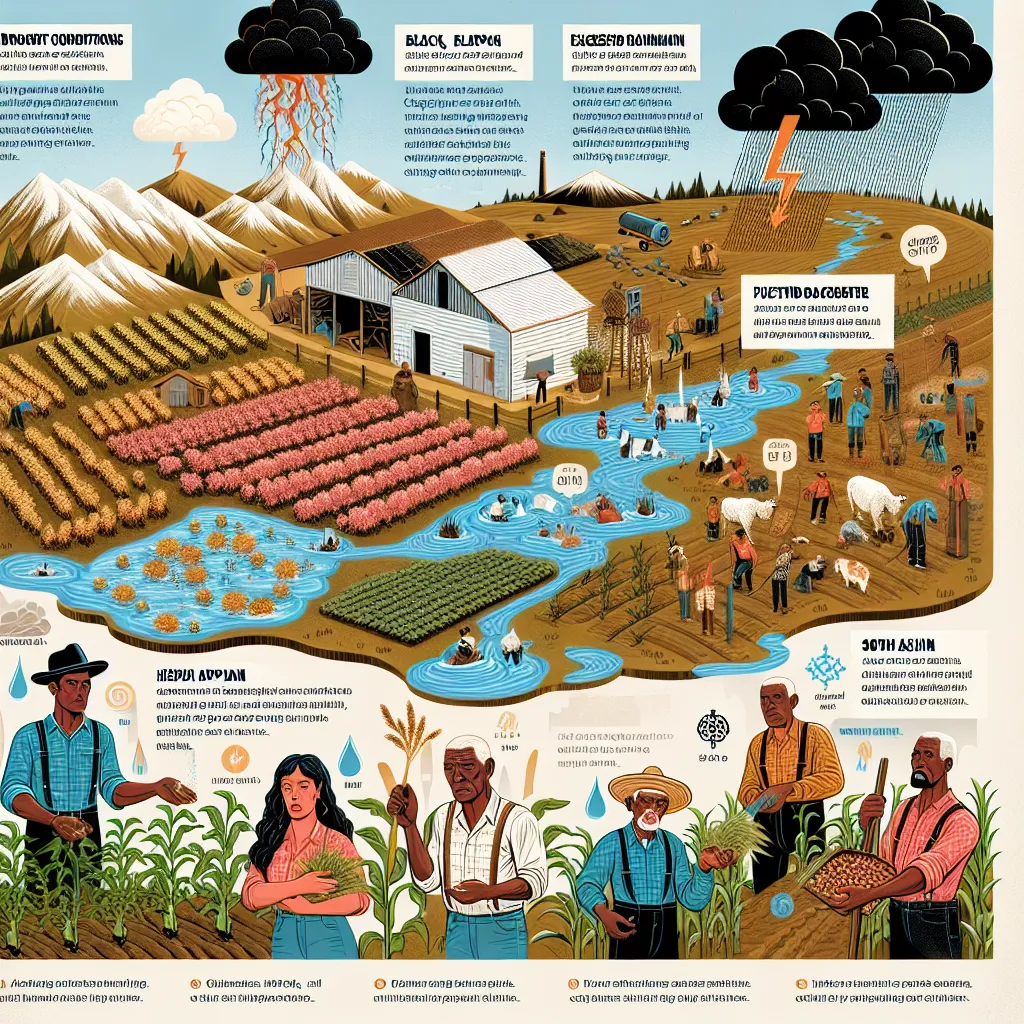As an experienced IELTS instructor, I’m here to provide you with a comprehensive IELTS Reading practice test focusing on the topic “How climate change is affecting global agricultural practices.” This practice test will help you prepare for the actual IELTS exam by familiarizing you with the format and types of questions you may encounter.
 Climate change impact on agriculture
Climate change impact on agriculture
Introduction
Climate change is one of the most pressing issues of our time, and its impacts are far-reaching, especially in the realm of global agriculture. This IELTS Reading practice test will explore how climate change is altering agricultural practices worldwide, challenging farmers to adapt to new conditions and threatening food security.
IELTS Reading Practice Test
Passage 1 – Easy Text
The Changing Face of Agriculture
Climate change is rapidly altering the landscape of global agriculture, forcing farmers and agricultural systems to adapt to new and often challenging conditions. As temperatures rise and weather patterns become increasingly unpredictable, traditional farming methods are being put to the test.
One of the most significant impacts of climate change on agriculture is the shift in growing seasons. Phenological changes are occurring, with plants flowering earlier and growing seasons extending in some regions. While this may seem beneficial, it can lead to mismatches between crop development and the availability of pollinators or the presence of pests.
Water availability is another crucial factor affected by climate change. Some areas are experiencing increased rainfall and flooding, while others face severe drought conditions. This variability in water supply poses significant challenges for irrigation systems and crop selection. Farmers must now consider drought-resistant crops or implement water-conserving techniques to maintain productivity.
The rise in global temperatures is also affecting crop yields. While some crops may initially benefit from higher CO2 levels and longer growing seasons, the overall impact is largely negative. Heat stress can damage crops, reduce yields, and affect the nutritional quality of food products. Additionally, warmer temperatures can lead to the proliferation of pests and diseases, further threatening crop production.
Livestock farming is not immune to these changes either. Heat stress in animals can lead to reduced productivity and increased susceptibility to diseases. Pasture quality and availability are also affected, potentially leading to food shortages for grazing animals.
In response to these challenges, farmers are adopting new technologies and practices. Precision agriculture, which uses data and technology to optimize farming practices, is gaining popularity. This approach allows farmers to use resources more efficiently and adapt more quickly to changing conditions.
Climate-smart agriculture is another emerging concept, focusing on increasing productivity while reducing greenhouse gas emissions and building resilience to climate change. This approach includes practices such as conservation tillage, crop rotation, and agroforestry.
As the effects of climate change continue to unfold, the agricultural sector must remain adaptable and innovative. The future of global food security depends on our ability to develop sustainable farming practices that can thrive in a changing climate.
Questions 1-5
Do the following statements agree with the information given in the reading passage?
Write:
TRUE if the statement agrees with the information
FALSE if the statement contradicts the information
NOT GIVEN if there is no information on this
- Climate change is causing plants to flower later in the season.
- Some regions are experiencing both increased rainfall and drought conditions due to climate change.
- Higher CO2 levels always lead to improved crop yields.
- Heat stress can affect the nutritional quality of crops.
- All farmers worldwide have adopted precision agriculture techniques.
Questions 6-10
Complete the sentences below.
Choose NO MORE THAN TWO WORDS from the passage for each answer.
- Changes in growing seasons can lead to mismatches between crop development and the availability of ___ or pests.
- Farmers are considering ___ crops to deal with water scarcity in some regions.
- ___ in animals can result in decreased productivity and increased vulnerability to diseases.
- ___ agriculture uses data and technology to optimize farming practices.
- Climate-smart agriculture aims to increase productivity while reducing ___ and building resilience to climate change.
Passage 2 – Medium Text
Global Agricultural Adaptation in the Face of Climate Change
The impact of climate change on global agricultural practices is becoming increasingly evident, necessitating significant adaptations in farming methods and crop management. As the world grapples with rising temperatures, shifting precipitation patterns, and more frequent extreme weather events, the agricultural sector finds itself at the forefront of climate change mitigation and adaptation strategies.
One of the most profound effects of climate change on agriculture is the alteration of crop suitability in different regions. As temperature and precipitation patterns shift, areas that were once ideal for certain crops may become less suitable, while new opportunities arise in previously unsuitable regions. This phenomenon, known as “crop migration,” is already observable in various parts of the world. For instance, wine grape cultivation is expanding into higher latitudes and altitudes, while traditional coffee-growing regions are facing challenges due to rising temperatures.
The changing climate is also influencing the prevalence and distribution of pests and diseases. Warmer temperatures can lead to the expansion of pest ranges, increased reproduction rates, and reduced winter mortality. This shift poses significant challenges for pest management strategies, often requiring farmers to adapt their practices or introduce new control methods. Similarly, plant diseases are showing altered patterns of occurrence and severity, necessitating adjustments in disease management approaches.
Water management has become a critical issue in many agricultural regions. While some areas face increased rainfall and flooding risks, others are experiencing prolonged droughts and water scarcity. This variability has led to the development and implementation of more efficient irrigation systems, such as drip irrigation and precision watering techniques. Additionally, there is a growing emphasis on water conservation practices, including the use of drought-resistant crop varieties and improved soil management to enhance water retention.
Soil health is another crucial aspect of agricultural adaptation to climate change. As extreme weather events become more frequent, soil erosion and degradation pose significant threats to agricultural productivity. In response, many farmers are adopting conservation agriculture practices, such as minimal tillage, crop rotation, and the use of cover crops. These methods not only protect the soil but also contribute to carbon sequestration, playing a role in mitigating climate change.
The livestock sector is also feeling the effects of climate change, with heat stress affecting animal productivity and well-being. Farmers are implementing various strategies to address this issue, including the use of shade structures, misting systems, and selective breeding for heat tolerance. There is also a growing interest in alternative livestock systems, such as silvopastoral systems, which integrate trees and pasture to provide shade and additional fodder for animals.
Technological innovations are playing a crucial role in agricultural adaptation. Precision agriculture, enabled by GPS technology, remote sensing, and data analytics, allows farmers to optimize resource use and respond more effectively to changing conditions. Climate modeling and early warning systems are helping farmers make informed decisions about planting times and crop selection. Additionally, genetic engineering and advanced breeding techniques are being employed to develop crop varieties that are more resilient to climate stresses.
The global nature of climate change impacts on agriculture has also highlighted the importance of international cooperation and knowledge sharing. Organizations such as the Food and Agriculture Organization (FAO) of the United Nations are working to facilitate the exchange of best practices and support developing countries in building resilience to climate change in their agricultural sectors.
As the effects of climate change continue to unfold, the agricultural sector must remain adaptable and innovative. The future of global food security depends on our ability to develop sustainable farming practices that can thrive in a changing climate while also contributing to climate change mitigation efforts.
Questions 11-14
Choose the correct letter, A, B, C, or D.
-
According to the passage, crop migration refers to:
A) The physical movement of crops from one region to another
B) Changes in suitable areas for growing certain crops
C) The transportation of crops to global markets
D) The genetic modification of crops to suit new environments -
Which of the following is NOT mentioned as an effect of warmer temperatures on pests?
A) Expansion of pest ranges
B) Increased reproduction rates
C) Reduced winter mortality
D) Enhanced pesticide resistance -
What is the main reason for adopting conservation agriculture practices?
A) To increase crop yields
B) To reduce labor costs
C) To protect soil and sequester carbon
D) To comply with government regulations -
The passage suggests that precision agriculture is enabled by:
A) Increased use of chemical fertilizers
B) Traditional farming knowledge
C) GPS technology and data analytics
D) Organic farming practices
Questions 15-20
Complete the summary below.
Choose NO MORE THAN TWO WORDS from the passage for each answer.
Climate change is significantly impacting global agricultural practices, requiring farmers to adapt their methods. One major effect is the alteration of crop suitability in different regions, a phenomenon known as (15) . The changing climate also affects the distribution of pests and diseases, necessitating new (16) strategies. Water management has become crucial, with some areas implementing efficient systems like (17) . Soil health is being addressed through conservation agriculture practices, which also contribute to (18) . In the livestock sector, farmers are using various methods to combat (19) , including shade structures and selective breeding. Technological innovations, such as (20) , are playing a vital role in helping farmers adapt to changing conditions.
Passage 3 – Hard Text
The Multifaceted Impact of Climate Change on Global Agricultural Systems
The intricate relationship between climate change and global agricultural practices is becoming increasingly apparent, with far-reaching consequences for food security, economic stability, and ecological balance. As the planet continues to warm, the agricultural sector faces unprecedented challenges that demand innovative solutions and systemic adaptations.
One of the most significant impacts of climate change on agriculture is the alteration of crop phenology – the timing of key developmental stages in plant growth. This shift has profound implications for crop productivity and management. For instance, the earlier onset of spring in many temperate regions has led to premature budding in fruit trees, making them more susceptible to late frost damage. Conversely, in some areas, delayed onset of favorable growing conditions has shortened the effective growing season, reducing overall yield potential.
The complex interplay between rising temperatures, changing precipitation patterns, and atmospheric CO2 levels presents both opportunities and challenges for crop production. While elevated CO2 concentrations can enhance photosynthesis and water use efficiency in some C3 plants (such as wheat and rice), these potential benefits are often offset by the detrimental effects of heat stress and water scarcity. Moreover, studies have shown that crops grown under elevated CO2 conditions may have reduced nutritional value, particularly in terms of protein content and essential micronutrients.
Climate change is also exacerbating the pressure on water resources, a critical factor in agricultural production. The intensification of the hydrological cycle has led to more frequent and severe droughts in some regions, while others experience increased flooding and waterlogging. This variability necessitates a paradigm shift in water management strategies, including the development of drought-resistant crop varieties, implementation of water-conserving irrigation technologies, and the adoption of climate-smart agricultural practices such as conservation tillage and improved soil management.
The shifting dynamics of pest and disease prevalence pose another significant challenge to global agriculture. Warmer temperatures and altered precipitation patterns are expanding the geographical range of many crop pests and pathogens, while also accelerating their reproductive cycles. This phenomenon has led to the emergence of new pest-crop interactions and the intensification of existing ones. For example, the coffee berry borer (Hypothenemus hampei), a major pest of coffee crops, has been observed at higher altitudes as temperatures rise, threatening production in traditional coffee-growing regions.
Livestock systems are equally vulnerable to the impacts of climate change. Heat stress in animals can lead to reduced productivity, impaired reproductive performance, and increased susceptibility to diseases. Moreover, climate change affects the quality and availability of animal feed, both in terms of pasture growth and the nutritional composition of forage crops. The livestock sector is also under scrutiny for its contribution to greenhouse gas emissions, prompting research into mitigation strategies such as improved manure management and the development of low-emission breeding lines.
The socio-economic ramifications of climate change on agriculture are profound and far-reaching. Shifting crop suitability zones and changing yields can lead to significant market disruptions, affecting both local livelihoods and global food prices. Small-scale farmers in developing countries are particularly vulnerable to these changes, often lacking the resources and adaptive capacity to respond effectively. This situation underscores the need for targeted support and capacity-building initiatives to enhance the resilience of vulnerable agricultural communities.
Adaptation to climate change in agriculture requires a multifaceted approach that integrates technological innovation, policy reform, and behavioral change. Precision agriculture, enabled by advances in remote sensing, data analytics, and artificial intelligence, offers promising tools for optimizing resource use and enhancing adaptive capacity. Genetic engineering and advanced breeding techniques are being employed to develop climate-resilient crop varieties with enhanced tolerance to heat, drought, and salinity.
However, technological solutions alone are insufficient. There is a growing recognition of the importance of ecosystem-based approaches to agricultural adaptation, such as agroforestry and the restoration of natural habitats to enhance landscape resilience. These approaches not only help to buffer agricultural systems against climate impacts but also contribute to biodiversity conservation and carbon sequestration.
Policy interventions play a crucial role in facilitating agricultural adaptation to climate change. This includes measures such as reforming agricultural subsidies to incentivize sustainable practices, investing in climate-resilient infrastructure, and strengthening weather forecasting and early warning systems. International cooperation is essential in this context, particularly in terms of technology transfer, capacity building, and coordinated research efforts.
As the agricultural sector grapples with the complexities of climate change, it is clear that business-as-usual approaches are no longer viable. The path forward requires a holistic, systems-based approach that recognizes the interconnectedness of climate, agriculture, and global food systems. By embracing innovation, fostering resilience, and prioritizing sustainability, the agricultural sector can not only adapt to the changing climate but also play a pivotal role in mitigating its impacts.
Questions 21-26
Complete the summary below.
Choose NO MORE THAN TWO WORDS AND/OR A NUMBER from the passage for each answer.
Climate change is significantly impacting global agriculture, affecting crop (21) and altering growing seasons. While increased CO2 levels can enhance photosynthesis in some plants, it may lead to reduced (22) in crops. Water management is becoming crucial due to more frequent (23) and flooding. The geographical range of crop (24) is expanding due to warmer temperatures. Livestock face challenges including heat stress and changes in feed (25) . Small-scale farmers in (26) are particularly vulnerable to these changes.
Questions 27-32
Do the following statements agree with the information given in the reading passage?
Write:
TRUE if the statement agrees with the information
FALSE if the statement contradicts the information
NOT GIVEN if there is no information on this
- Climate change has led to a uniform increase in crop yields across all regions.
- The coffee berry borer has been found at higher altitudes due to rising temperatures.
- Precision agriculture relies solely on remote sensing technology.
- Ecosystem-based approaches to agricultural adaptation can contribute to carbon sequestration.
- All countries have implemented policies to incentivize sustainable agricultural practices.
- The agricultural sector can play a role in both adapting to and mitigating climate change impacts.
Questions 33-40
Complete the sentences below.
Choose NO MORE THAN THREE WORDS from the passage for each answer.
- The earlier onset of spring in temperate regions has made fruit trees more vulnerable to ___.
- Studies have shown that crops grown under elevated CO2 conditions may have lower levels of protein and ___.
- Climate change has led to an intensification of the ___, resulting in more extreme weather events.
- The development of ___ is one strategy to address water scarcity in agriculture.
- Heat stress in livestock can lead to reduced productivity and ___.
- ___ in developing countries often lack the resources to adapt effectively to climate change.
- Advanced breeding techniques are being used to develop crop varieties with enhanced tolerance to heat, drought, and ___.
- International cooperation is essential for technology transfer, capacity building, and ___ in agricultural adaptation to climate change.
Answer Key
Passage 1
- FALSE
- NOT GIVEN
- FALSE
- TRUE
- FALSE
- pollinators
- drought-resistant
- Heat stress
- Precision
- greenhouse gas emissions
Passage 2
- B
- D
- C
- C
- crop migration
- pest management
- drip irrigation
- carbon sequestration
- heat stress
- precision agriculture
Passage 3
- phenology
- nutritional value
- droughts
- pests and pathogens
- quality and availability
- developing countries
- FALSE
- TRUE
- FALSE
- TRUE
- NOT GIVEN
- TRUE
- late frost damage
- essential micronutrients
- hydrological cycle
- drought-resistant crop varieties
- impaired reproductive performance
- Small-scale farmers
- salinity
- coordinated research efforts
By practicing with this IELTS Reading test focused on how climate change is affecting global agricultural practices, you’ve engaged with a highly relevant and complex topic. Remember to time yourself and review your answers carefully. For more practice on related topics, you might find our articles on the impact of climate change on water availability in arid regions and the [


